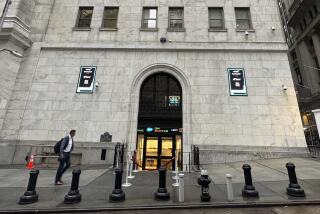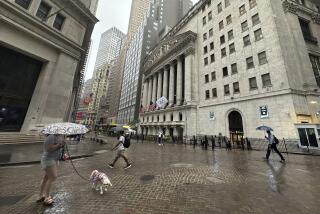Stock Market Gyrations Continue to Confound Experts
NEW YORK â Like many other money managers, Lew Kleinrock is relying more on intuition and less on professional advice in picking stocks these days.
âA number of Saturdays ago, I went to the gas pump for the third time in a week and found prices lower again,â said the head of Independence Investment Associates, the Boston money-management arm of John Hancock Mutual Life Insurance.
But, he added, âthereâs no way that extra money was going into the bank.â And he figured that if he was spending it, so were other consumers, so Independence loaded up on such mass-market retailers as K mart, J. C. Penney and Zayre.
The investment paid off, especially in Penney, which has risen almost $20 to about $82 in less than two months. Thatâs a relief, because as Kleinrock says, âI donât know any more about where this market is going than anyone else.â
The stock market confounded the experts again in recent days when, after a sleepy month that had many analysts predicting a major selloff, it rebounded in five straight, strong sessions. âI was sure it would hit 1,700 before it hit 1,900,â Kleinrock said of the Dow Jones industrial average, which dropped only as far as 1,758.18 on May 19 before rebounding to Thursdayâs record 1,882.35.
In the five days of trading that ended Thursday, the Dow jumped more than 107 points, then gave up 5.64 points Friday to end the week at 1,876.71.
To Eugene Peroni, technical analyst for the Los Angeles investment house of Bateman Eichler, Hill Richards, this weekâs market strongly resembled that of late January, which kicked off a strong rally after weeks of languor. Trading volume on the New York Stock Exchange reached a recent nadir of just under 86 million shares on May 19, just as it had sunk to about 85 million shares on Jan. 20, he observed.
âThat suggests uncertainty and indifference about the marketâs trendâ among investors, he said, âand that led to a bandwagon effect as soon as money managers saw the market heading up.â
Mushrooming of Negative Sentiment
Peroni also considered the market, which had declined sharply from April 22 to May 19, to be âoversold and unlovedâ at that time. âIt had made a 110-point correction,â he said, âand bearish sentiment was quite strong.â
Other market professionals had noticed a mushrooming of negative sentiment--which in stock market practice is often taken as a harbinger of a bull rally--early in May. âThere was more skepticism at 1,750 (that is, when the Dow average was just above that level on May 16-19) than at any time in the last six months,â said Joseph D. Feshbach, market strategist for Prudential-Bache Securities. Mutual funds had accumulated exceptionally high cash positions, equivalent to nearly 10% of their assets, he noted. The put-call options ratio--that is, the ratio of investors betting on falling prices compared to those betting on a rally--reached 65 to 35 on May 19.
And a widely followed survey of 70 market advisory newsletters and 20 brokerage houses conducted by Hadady Corp. of Pasadena showed bullish sentiment among only 37%, close to a low for the year.
Feshbach took those figures as an indication to buy, and he told clients that he considered the Dow to have bottomed out on May 19. âFortunately, I hit it right on the nose,â he said. âTo be honest, I donât know why the marketâs been doing what it has.â
The last six sessions have again made bullish predictions the rule, although few professionals can put their finger on any fundamental reasons for optimism.
âThereâs no specific news to account for the rally except that people werenât expecting it,â said Newton Zinder, chief market analyst for E. F. Hutton.
Yet many analysts are promoting similar stocks, particularly retailers, food processors and entertainment and leisure issues. All benefit from disinflationary influences and from such other developments as the apparent tendency of most Americans to take domestic vacations this year.
âPeople will stay home and shop,â said Philip B. Erlanger, chief technical analyst for the Hartford, Conn., investment firm of Advest Group. Casino and hotel stocks also have turned up, he said.
There is plenty of residual skepticism among market followers over whether the U.S. economy will enter a genuine recovery this year, despite Thursdayâs announcement that the Commerce Departmentâs index of leading economic indicators for April showed its largest increase in nearly three years.
âMuddle Throughâ Second Half
Two components contributed most to the indexâs showing, Zinder said: the growth in the nationâs money supply and the rise in stock prices themselves, rather than real activity in the industrial economy.
âThe specific economic numbers were not as robust as the entire index indicated,â he said. Among other components, business equipment orders and the prices of sensitive materials were down.
âWe tend to think (the market) will muddle through the second half,â said Ben Niedermeyer, a money manager at Denver-based Janus Capital. Niedermeyer said Janus committed more money to the stock market in the third week of April on the reasoning that a sluggish economy would send interest rates still lower, a positive development for stock prices.
More to Read
Inside the business of entertainment
The Wide Shot brings you news, analysis and insights on everything from streaming wars to production â and what it all means for the future.
You may occasionally receive promotional content from the Los Angeles Times.










